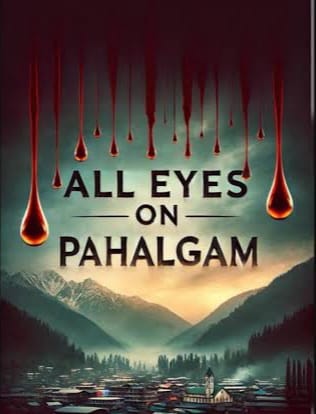On April 22, 2025, the serene meadows of Pahalgam in Jammu and Kashmir were transformed into a scene of horror as a terrorist attack claimed the lives of 28 individuals, including 25 Indian nationals, a Nepalese tourist, and a local resident. The attack, which occurred in the picturesque Baisaran Valley, has been described as one of the deadliest assaults on civilians in the region in recent years.
THE ATTACK : A COORDINATED ASSAULT
At approximately 2:50 PM, a group of militants, reportedly seven in number and armed with M4 carbines and AK-47s, launched a coordinated attack on tourists in the valley. Eyewitnesses recounted that the attackers demanded the victims’ names and religious affiliations before opening fire. Some victims were reportedly asked to recite Islamic verses, Kalma, with those failing to comply being shot at close range. A local Kashmiri Shia Muslim, Syed Adil Hussain Shah, attempted to protect the tourists by confronting the assailants but tragically lost his life in the effort. The militants are believed to have recorded the assault using body cameras, a tactic associated with Lashkar-e-Taiba propaganda. The Resistance Front (TRF), an offshoot of Lashkar-e-Taiba, claimed responsibility for the attack, citing opposition to alleged demographic changes in the Kashmir Valley.
RESPONSIBILITY AND MOTIVE
The Resistance Front (TRF), a proxy group believed to be affiliated with Lashkar-e-Taiba, claimed responsibility for the attack. Their statement cited resistance to alleged “demographic changes” facilitated by the issuance of domicile certificates to non-locals as the motive behind this heinous act.
CASUALTIES AND VICTIMS
The victims hailed from various parts of India, including Arunachal Pradesh, Karnataka, Kerala, Maharashtra, Odisha, Gujarat, Haryana, West Bengal, and Uttar Pradesh. Among the deceased were a 26-year-old Indian Navy officer and an Intelligence Bureau official. The injured, numbering over 20, included individuals from Gujarat, Tamil Nadu, and Maharashtra. The attack also resulted in the deaths of two locals from Jammu and Kashmir and two foreign nationals from Nepal and the United Arab Emirates
HISTORICAL PARALLELS
This incident echoes past atrocities aimed at drawing global attention by targeting civilians during high-profile international visits:
- 2000 Chittisinghpora massacre: 36 Sikhs were killed during President Bill Clinton’s visit to India.
- 2002 Kaluchak attack: 23 civilians, including 10 children, were murdered during a U.S. diplomatic visit.
These patterns indicate a deliberate strategy by terror groups to disrupt diplomatic engagement and showcase unrest in Kashmir.
GOVERNMENT RESPONSE AND SECURITY MEASURES
In the wake of the attack, the Jammu and Kashmir government announced ex-gratia payments of Rs 10 lakh each for the families of the deceased and Rs 2 lakh for those with serious injuries . The central government has initiated a comprehensive review of security arrangements, with plans to deploy additional Army and paramilitary forces to address potential security gaps. This includes preparations for the upcoming Amarnath Yatra, which passes through Pahalgam.
NATIONAL AND INTERNATIONAL REACTIONS
Prime Minister Narendra Modi condemned the attack, vowing that those responsible would be brought to justice. Union Home Minister Amit Shah traveled to Srinagar to assess the situation and coordinate the security response. International leaders, including U.S. President Donald Trump and U.K. Prime Minister Sir Keir Starmer, condemned the attack, expressing solidarity with India .
CONSEQUENCES OF THE ATTACK
- Security Setback: The incident challenges the narrative of peace and progress in Jammu & Kashmir following the abrogation of Article 370, raising doubts about the region’s stability.
- Tourism and Economy: As a key tourist destination, Pahalgam faces a severe decline in footfall, especially during the peak summer season, threatening the livelihoods of thousands dependent on the industry.
- Global Implications: Coming at a time of heightened international engagement, the attack risks diplomatic fallout, while giving adversarial nations, particularly Pakistan, a platform to push destabilizing narratives.
- Communal Strain: The alleged identity-based targeting raises concerns about rising communal tensions, potentially leading to polarization — a goal terrorists often seek to achieve.
THE PATH FORWARD
- Precision Counter-Terror Operations: Launch intelligence-driven, joint efforts involving the Army, CRPF, and J&K Police to track down and neutralize the perpetrators swiftly.
- Responsible Communication: Authorities must resist communal framing and instead foster unity, denying militants the social divide they aim to exploit.
- Tourism Confidence Revival: Provide compensation to victims, ensure enhanced security for visitors, and work closely with stakeholders to restore faith in Kashmir’s tourism.
- Enhanced Surveillance: Implement technology-based monitoring — including UAVs, facial recognition, and terrain mapping — especially in high-risk, inaccessible zones.
- Strategic Diplomacy: Utilize forums such as the UN, G20, and bilateral platforms to highlight the continuing threat of cross-border terrorism and build international consensus against it.
The Pahalgam terror attack is a chilling reminder of the enduring and evolving threats in Kashmir. It underscores the urgency of a balanced response — one that ensures security, strengthens diplomacy, and preserves communal harmony. In the face of terror, national unity and resilience are India’s strongest answers.



